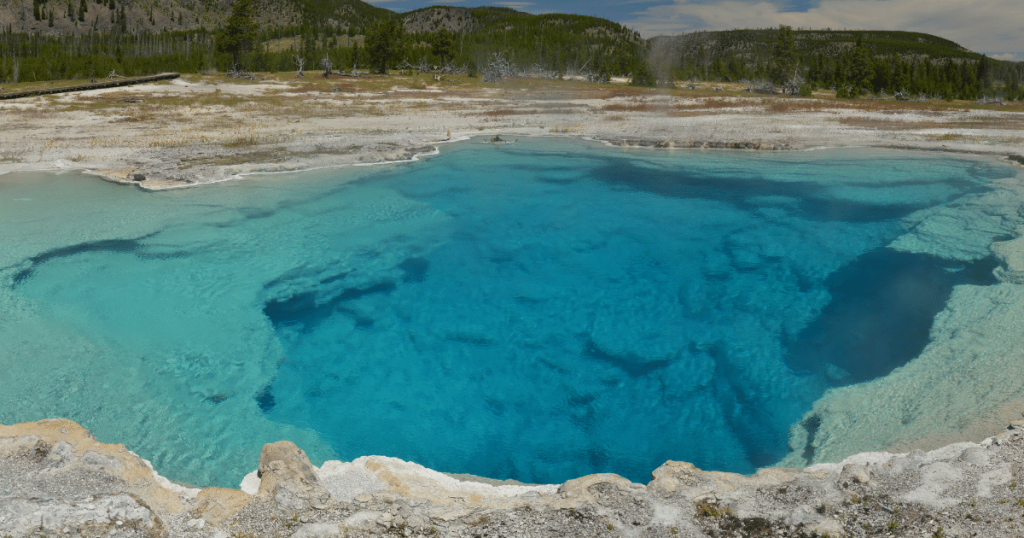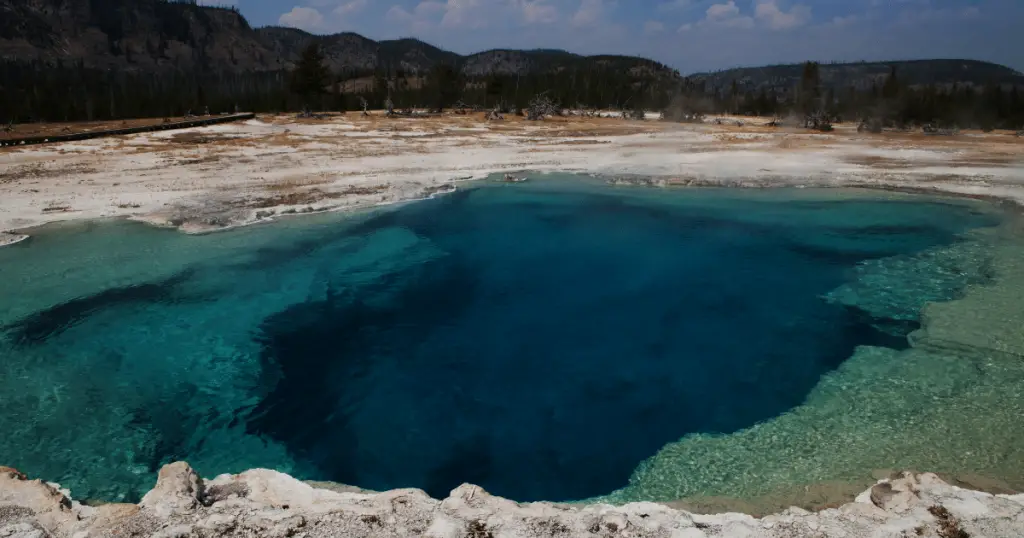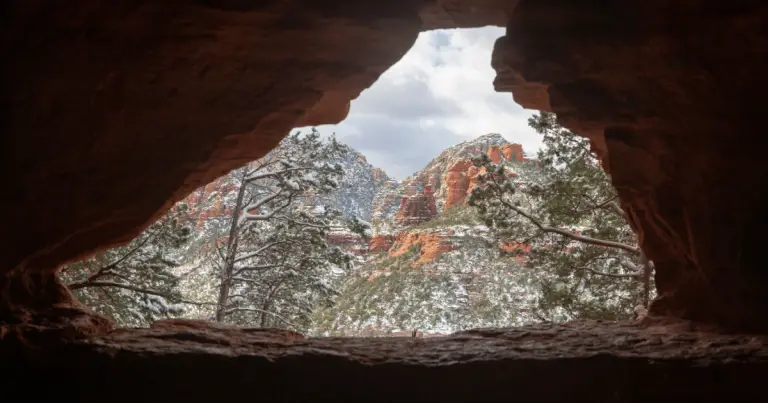Sapphire Pool Yellowstone: Everything You Need to Know
Yellowstone National Park is home to many natural wonders, and the Sapphire Pool is no exception. One of the lesser-known but no less impressive attractions, it is tucked away in the Norris Geyser Basin, far from the bustling crowds of Old Faithful. Surrounded by trees and a gentle trail leading up to it, the Sapphire Pool Yellowstone is a sight to behold.

Sapphire Pool: A Gem Amidst Geothermal Wonders
Nestled within the dynamic geothermal landscape of Yellowstone’s Norris Geyser Basin, the Sapphire Pool is a glorious azure spectacle.
Its vivid cobalt hues, which lend the pool its name, are primarily due to its depth and clarity. The collection is so deep that it absorbs all colors of sunlight except for blue, which is instead scattered, rendering the water its distinct sapphire-like appearance.
Additionally, the thermophilic bacteria inhabiting the pool further enhances the brilliant blue color. These heat-loving microorganisms form colorful mats around the edges, contributing to the vibrant spectacle.
The Sapphire Pool Yellowstone is more than just a feast for the eyes. It is also impressively large, with a diameter of approximately 18 feet. Depths, though hard to measure due to its geothermal nature, are estimated to reach as much as 30 feet, making it one of the deeper pools in the park.
The Origin of the Name”Sapphire Pool”
Like its captivating allure, the name “Sapphire Pool” carries its own tale. The Sapphire Pool got its name from the early explorers of Yellowstone National Park, who were mesmerized by its exceptional beauty. Captivated by the pool’s striking blue color, resembling that of a sapphire gemstone, they coined the name “Sapphire Pool.”
Sapphires, the precious gemstones, are renowned for their dazzling blue hues ranging from light to deep cobalt. When sunlight dances off a sapphire, it creates a spectacular play of light reminiscent of the Sapphire Pool’s breathtaking, shimmering surface.
The naming of the Sapphire Pool stems from this visual connection, linking the natural beauty of the pool with the enchanting allure of sapphire gemstones.
The historical context of the pool’s naming is a testament to the human propensity to find resonances of familiar beauty in the natural world. The name “Sapphire Pool” vividly encapsulates the phenomenon that those early explorers witnessed – a body of water astonishingly deep and clear, dappled with sunlight and reflecting a blue that rivaled the most precious of gemstones.

The Hydrothermal Ecosystem
With its unique geothermal characteristics, the Sapphire Pool in Yellowstone is a sanctuary for a distinct set of organisms known as extremophiles. These microorganisms thrive in extreme environments and are considered sterile or lethal to most life forms.
In the case of the Sapphire pool, these extremophiles are thermophiles, organisms that thrive in unusually high temperatures. One of the most fascinating aspects of these thermophilic extremophiles is their contribution to the Sapphire Pool’s distinctive coloration.
These microorganisms are pigmented, and as they form dense communities or ‘mats’ near the pool’s edges, they lend their vibrant colors to the mix. The blend of the sapphire-blue water, resulting from the physical properties of the collection, and the colorful mats of thermophiles create the unforgettable spectacle of the Sapphire Pool.
But the role of these extremophiles goes beyond adding color. They are essential actors in maintaining the delicate balance of the hydrothermal ecosystem.
Despite the harsh conditions, these microorganisms form a thriving community, breaking down organic matter and recycling nutrients. In so doing, they play a critical role in sustaining the life cycle within the extreme environment of the Sapphire Pool.
The Surrounding Area and Trails
The Sapphire Pool is located in the captivating Biscuit Basin area, a geothermal hotbed within the larger Upper Geyser Basin. Biscuit Basin is a unique cluster of thermal features, its name stemming from the biscuit-like deposits that once surrounded Sapphire Pool.
Though the ‘biscuits’ were obliterated by a major eruption in the 1950s, the Biscuit Basin remains a fascinating area, rich in geothermal marvels and scenic beauty.In the vicinity of the Sapphire Pool, Jewel Geyser and Shell Geyser stand as remarkable geothermal attractions.
Jewel Geyser, named for the beaded sinter formations that adorn its vent, offers frequent eruptions which, while not as large as those of famous geysers like Old Faithful, are nonetheless impressive.
Shell Geyser, in contrast, is known more for its unique, shell-shaped crater rather than its modest eruptions, which can be seen during active periods.

Biscuit Basin also boasts a range of accessible hiking trails, catering to different fitness levels and adventurousness. For instance, the Biscuit Basin Loop Trail is an easy 2/3-mile round trip that offers visitors close-up views of numerous thermal features, including the Black Opal Pool, Wall Pool, and, of course, the Sapphire Pool.
The Mystic Falls Trail, starting from Biscuit Basin, provides a moderate to challenging hike for those seeking a more challenging hike. This 2.4-mile round trip offers breathtaking views of the 70-foot Mystic Falls and a panoramic view of the Upper Geyser Basin from an elevated viewpoint.
Protecting the Sapphire Pool and Its Ecosystem
Like many of Yellowstone’s geothermal wonders, the Sapphire Pool is under pressure due to the impact of tourism. The pool’s striking beauty draws thousands of visitors every year, and while their interest is commendable, it challenges the preservation of this delicate ecosystem.
Trampling around the pool can cause physical damage, and introducing foreign substances, whether unintentional littering or the intentional throwing of coins into the pool, can disrupt the unique chemistry that supports the pool’s thermophilic life.
Recognizing these threats, Yellowstone National Park authorities have been proactive in their conservation efforts. These include enforcing regulations prohibiting off-trail walking and throwing objects into thermal features. Educational signage and ranger-led programs aim to increase visitor awareness about the delicate nature of these features and the importance of leaving no trace.

Despite these efforts, challenges persist. The sheer volume of visitors, especially during peak seasons, can be overwhelming. Ensuring compliance with park regulations is a constant task.
Further, climate change poses a broader, potentially more damaging threat. Changes in temperature and precipitation patterns could disrupt the geothermal processes that drive features like the Sapphire Pool.
To preserve Yellowstone’s geothermal wonders for future generations, ongoing conservation efforts must be coupled with increased public awareness and adherence to the park’s principles of respect and preservation.
Conclusion: Sapphire Pool Yellowstone
Sapphire Pool and the surrounding Biscuit Basin area in Yellowstone National Park are true testaments to the Earth’s geothermal power and the tenacity of life that thrives in the most extreme conditions.
The vibrant hues of Sapphire Pool and its unique geothermal features invite visitors to marvel at the wonders of nature. However, it’s crucial to remember the delicate balance of this ecosystem and the challenges it faces due to human activity and climate change.
As visitors and benefactors of such natural beauty, we are responsible for respecting and preserving these geothermal treasures. By adhering to park regulations and embracing a conservation mindset, we can ensure that future generations will also have the opportunity to appreciate the mesmerizing beauty and scientific wonder of Sapphire Pool.







